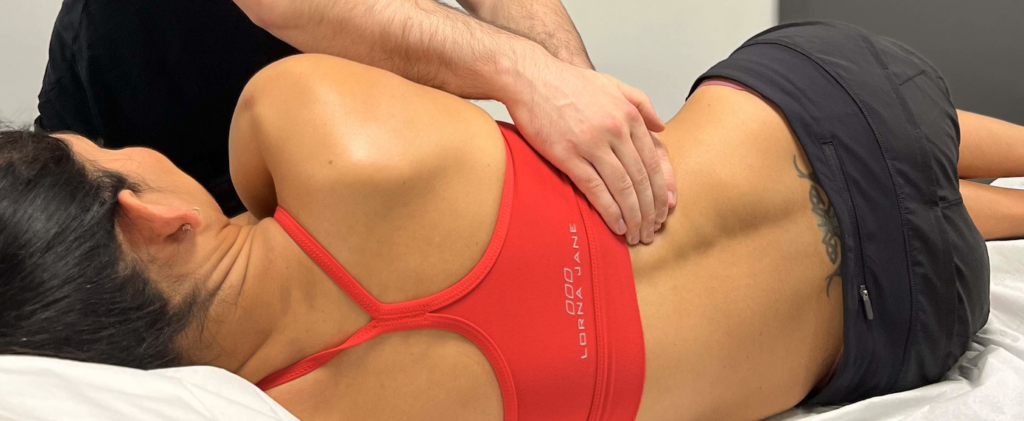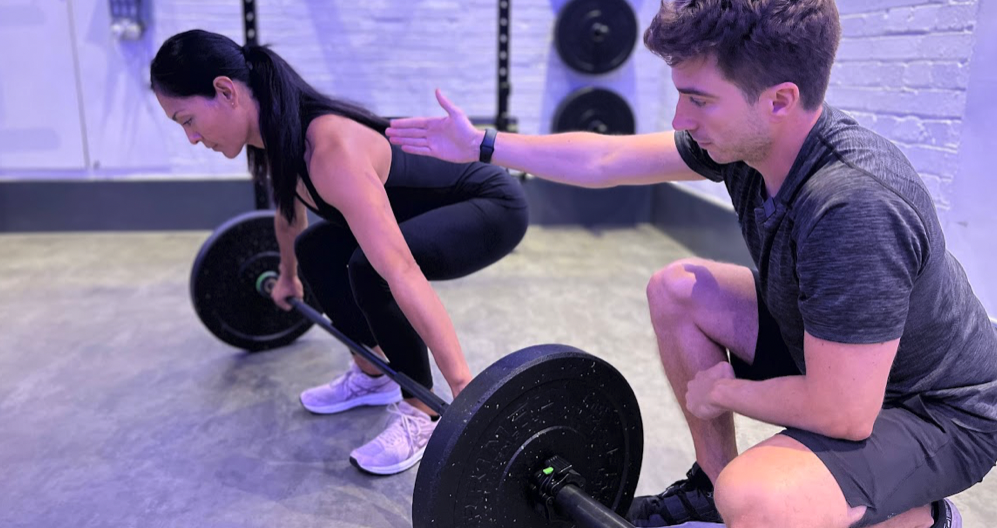The dreaded pulled back. Not only frustrating and inconvenient, but painful as well. And seems to always happen from the most unexciting of tasks, like a sneeze, or picking up a pen!
If we knew exactly when it was going to occur, I’m sure everybody would ‘squat down’ with perfect technique to pick up the pen, or farmers carry the shopping from the car standing tall and strong. But we never really know and that’s why much of the focus is to the ‘cure’ of a pulled back rather than the prevention.
Here, we’ll look at what a pulled back is – and take a detailed look at what some gym- and therapy-based work might look like for a pulled back.
What is a ‘pulled’ back muscle?

A pulled muscle is the general name used to describe a muscle strain.
A strain occurs when muscle fibres tear, the severity of that tear can be very minor or extreme.
If you’re lucky the pain will only last a few days, but if you’re unlucky, a pulled muscle can leave you in agony for weeks! The good news is that you can manage and treat the issue, and there are even methods to reduce the chances of it happening again in the future.
What are some symptoms of a pulled back muscle?
Other than the general feeling of ‘not being able to move’, what else can you expect to be a symptom of a pulled back muscle?
Well, firstly we need to understand where the ‘pulled muscle’ has occurred and we can then identify possible symptoms. The back has three distinct portions; the lower, the middle and the upper back. Each with slightly different common areas of pain.
A pulled muscle in the lower back can be a real pain in the arse, quite literally! It can feel like a strip of tight & tender muscle going across the small of your back and sometimes into the top of your glutes. Not comfortable at all! You may find it particularly challenging to move at the hips, so this would include bending forwards or squatting down to tie your shoe laces.
If the pain continues for a longer time, it’s not only physical symptoms people may experience. Struggling to sleep in a comfortable position can make the next day very challenging, and before long this will start to affect mood, energy and general focus during the day.
What kind of treatment is good for a pulled back muscle?

The treatment plan for a pulled back muscle will vary between individuals. We need to consider how the pull occurred, the severity of it and how much it is impacting somebody’s life.
A severe back pull from a car collision would require medical diagnosis before treatment plan is decided, any may even need prescribed medication to assist the recovery process and pain management.
A pull from awkwardly lifting the TV may be treatable at home with low maintenance methods. Applying cold straight away can reduce swelling of the muscle tissue and kickstart the recovery process.
Also – rest as soon as possible! That doesn’t mean lying still for days and days, but allowing some time to relax the muscle and stop the movements which may have cause the pull in the first place.
Once movement is restored, stretching the area may be beneficial to getting fresh blood flow to the muscle and help with further recovery. Remain cautious with this, it’s easy to add more but more difficult to take away if you overdo it. We don’t want another pulled muscle!
What would you suggest to someone who had a pulled back muscle?
On top of what has already been mentioned above, when someone experiences a back pain I would always recommend that they go and see a qualified professional who can help and guide further such as an osteopath, physiotherapist or chiropractor. Whilst in the acute phases of the injury the physiotherapist or qualified professional may not be able to perform a direct treatment/immediate recovery treatment, they will be able to advise on an effective recovery strategy with self exercise which can be done throughout each day at home or in the workplace.
On top of going to see a qualified professional, we would always recommend that you keep mobile and try to avoid staying seated for long periods of time as this will likely tighten muscles further and cause increased tension.
In general, when your body is in pain or experiencing pain, the muscles will become tight. By performing gentle movements like walking or just moving around the home or the workplace you can increase the mobility which will therefore help with some relief of pain. We would not recommend carrying out heavy exercises or doing anything that causes more pain than you are already in.

What are some at-home pain relief techniques if you have a pulled back muscle?
There are a number of things that you can do when at home when experiencing back pain or when you have a pulled back muscle. As per the above, it is recommended that light movement such as walking or moving around your home or place of work is performed in order to prevent other muscles around the body getting tight and potentially causing even more discomfort.
Another simple, but effective, exercise is to lie on your back with your feet up at a 90° angle on the sofa. Imagine lying on the floor on your back with your knees bent and your calf muscles rested on your sofa. In this position your pelvis is neutralised and the muscles in and around the lower back which connects to the pelvis are allowed to relax. By allowing these muscles to relax, you can help with some pain relief and also aid the process of recovery.
It must be noted that in any instance of muscle tear, it takes time to heal and often times specific rehabilitation exercises and stretches are required.
What professional therapies can help with a pulled back muscle?
Physiotherapy is an excellent first stop if you have experienced back pain or have torn a muscle in your back.
An Osteopath can also provide an excellent treatment and recovery plan to help you on the road to recovery.
We would advise always ensuring that you see a qualified health professional and not just a massage therapist who thinks they know what they are doing. The back in particular is a highly complex structure and it is essential that you hire the right professional, with the right experience to help you.
Long-term, remaining strong and supple is the ultimate recovery tool and furthermore helps with prevention of further injury recurrence.
How can you prevent pulled back muscles going forward?
What can we do to ensure we don’t end up in this pickle again? Well, we know a pulled muscle is sometimes out of our control, but there are things we can do to reduce the chances of it happening again.
A common belief is that strength training puts your back at constant risk of injury, and should be completed with absolute caution. When in fact, strength training is perfectly safe, assuming correct technique is used and can be pivotal in improving your back health & avoiding further pulled muscles.

Collisions, falls, awkward landings, lifting off balance are all big causes of pulled muscles. Strength training improves our muscular strength, coordination, ability to absorb force (land) and of course, lift things properly. We could say it’s a match made in heaven!
If you’re looking for a fix after your most recent pulled muscle, strength training is still our top pick. Exercises should be adapted to suit your current fitness level, and as always performed with solid technique or under the watch of an experienced coach.
If you’d like to hear more about how we get get you back on the road to being pain free – why not get in touch?

